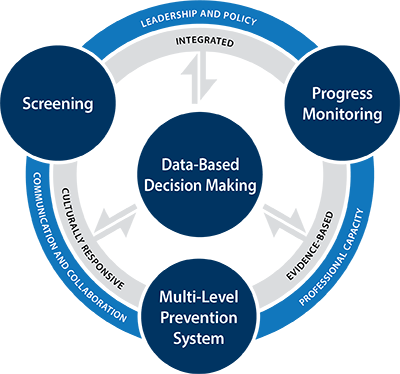This article was originally drafted April 2018, but includes updated information as of August 2020.
At this very moment states and districts use dozens of acronyms, most commonly MTSS (multi-tiered systems of support) and RTI (response to intervention or instruction), to refer to a tiered system of support. You may have also noticed that sometimes in education we take a simple concept and turn into an overly complex system of forms and processes. For those in schools implementing a tiered system of support, you may be experiencing just that. MTSS/RTI can begin to feel like more paperwork, more meetings, and more hoops to jump through as opposed to an effective prevention model for supporting all students. I have found that when schools start to lose their way or begin to feel overwhelmed with MTSS/RTI, it is important to get back to basics. We need to ask ourselves, what are we doing and why are we doing it? Only then can we start to identify ways to simplify our processes and ensure that what we are doing works for teachers and students.
What are the basics of MTSS/RTI?
The National Center on Response to Intervention (NCRTI) now MTSS Center, in its seminal piece Essential Components of RTI- A Closer Look at Response to Intervention (2010), provided a definition that outlined four essential components of the MTSS/RTI framework:
MTSS/RTI integrates assessment and intervention within a multi-level prevention system to maximize student achievement and to reduce behavioral problems. With MTSS/RTI, schools use data to identify students at risk for poor learning outcomes, monitor student progress, provide evidence-based interventions, adjust the intensity and nature of those interventions depending on a student’s responsiveness, and identify students with learning disabilities or other disabilities (according to state law).
Simple, right? Although maybe not the prescriptive approach you were looking for, it does provide the four basic, or essential components, of the MTSS/RTI framework. The graphic below was originally designed by the NCRTI and other stakeholders to help schools reduce the complexity of MTSS/RTI by showing how the basic components work together. It was updated by the MTSS Center to reflect a more integrated approach.

- Data-based decision making - Data analysis and decision making are central to the success of MTSS/RTI. Although it does require regular meetings, the intended outcome is to provide a structure for teams to use progress monitoring and screening data to make efficient and effective decisions about instruction, movement within the multi-level prevention system, and disability identification (in accordance with state law). If schools use validated and systematic procedures, teachers will find less complex paperwork, more timely decisions, and overall benefit to their instruction.
- Screening – Screening data are often the first data that teams use for decision making. The primary goal of screening is to assist schools in identifying students at risk for poor learning outcomes so they can prevent more complex learning needs in the future. A poorly chosen screening tool can create challenges for schools. It is recommended that schools select a brief, valid and reliable tool from the Academic Screening Tools Chart or Behavior Screening Tools Chart to reduce the complexity of screening administration and data analysis.
- Progress monitoring – Although progress monitoring is strongly associated with improved student outcomes, it can also feel time consuming and overwhelming. It is essential because it helps us assess students’ academic and behavior performance, quantify a students’ rate of improvement or responsiveness to instruction, and evaluate the effectiveness of instruction. To reduce the complexity of your system, select tools from the Academic Progress Monitoring Tools Chart or Behavior Progress Monitoring Tools Chart that are brief, valid and reliable and can be easily implemented within your school’s context. In many cases, publishers of screening tools also offer an aligned progress monitoring tool. Remember, very frequent progress monitoring (i.e., weekly) is only necessary for the 3-5% percent of your population requiring intensive intervention. Less frequent progress monitoring, monthly or bimonthly, is usually sufficient for the 15-20% of students receiving Tier 2 interventions.
- Multi-level prevention system – There is consensus that an effective MTSS/RTI model includes three tiers of instructional intensity or prevention. Tier 1 includes high-quality core instruction delivered through universal design principles and accommodations. Adequate professional development should be provided to all teachers to ensure Tier 1 curriculum and instruction are delivered with fidelity. To reduce the complexity of your model at Tier 2, select standardized academic interventions or behavior interventions shown to have large impacts on student outcomes. Avoid interventions that lack evidence about their effectiveness or have only shown small impact. This reduces the length of time students need to be in intervention and reduces the need for more complex instruction at Tier 3. For those very few students (3-5%) needing intensive support at Tier 3, use standardized approaches to intensification like data-based individualization to simplify problem solving and accelerate progress for those students with the most significant learning needs.
Learn More About MTSS/RTI
Regularly reflecting on the basics can help make implementation of MTSS/RTI less complex and more effective. Check out these resources to identify other ways for reducing the complexity of your MTSS/RTI implementation.
- 10 Steps to Make RTI Work in Schools
- Tools to Support Intensive Intervention Data Meetings
- Academic Screening Tools Chart
- Academic Intervention Tools Chart
- Behavior Intervention Tools Chart
- Academic Progress Monitoring Tools Chart
- Behavior Progress Monitoring Tools Chart
- Multi-Tiered System of Supports (MTSS) Fidelity of Implementation Rubric
